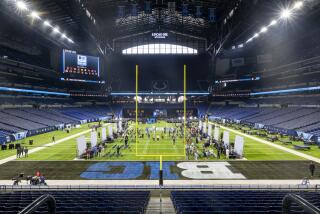Basketball Committee May Use Suspensions to Help Deter Fighting
- Share via
SPRINGFIELD, Mass. — If college basketball’s chief rulesmaker has his way, any player or coach involved in a fight during a game next season will face at least a two-game suspension.
“The college game is too great to allow it to be ruined by fisticuffs,” said Dr. Edward Steitz, the Springfield College athletic director who has been secretary-editor of the National Collegiate Athletic Assn. basketball rules committee for 21 years.
Before leaving for the committee’s meetings this week at Kansas City, Mo., Steitz said he expected the group to enact at least a one-game suspension for fighting. But he said he would push for at least a two-game suspension, and would urge conferences and university presidents to tack on even tougher penalties.
“Depending on the seriousness of the altercation, I can see suspensions of up to a season,” Steitz said. “We’re the guardians of the game and we can’t kick this under the rug. We’ve got to move quickly and forcefully. The ugly fight scenes we’ve seen this season have no place in an educational setting.”
He said more fights occurred this season than in any of his 30 years in the college game.
“And the really scary thing is the involvement of spectators. There can be serious or even fatal injuries in that kind of brawl situation.”
Steitz blamed the rise in violence partly on the increased pressure and rewards for players, coaches and schools to make the NCAA tournament. But he said that was no excuse.
Under current rules, referees can do no more than eject players or coaches from a game because of involvement in a fight, and schools have been reluctant to take additional disciplinary action.
“Unfortunately, there are not too many college presidents that are going to suspend their superstar,” Steitz said.
The NCAA, which has jurisdiction only over the national tournament, said it would use its powers to disqualify from further tournament play any player involved in a fight. The tournament has so far been free of fights.
“It’s not just the player alone,” said Steitz, who would empower game referees to hand out suspensions. “The coaches have to take more responsibility, and we certainly are not going to tolerate any violent act on their part.
“The officials need to call the cheap shot--the elbow, the hand-checking--and put an end to the verbal harassment and the slurs we hear on the court,” he said. “And the administrators need to become more involved in crowd control.”
Steitz’s annual survey of more than 2,000 college coaches, referees, administrators and sportswriters disclosed sharp disagreement among referees and coaches as to whether fouls that often lead to fights were being called properly. Twice as many officials as coaches thought that officials were doing a better job of policing rough play in games.
Of the 641 coaches polled, fewer than 35% thought the officials were doing a better job of calling illegal screens, 43% thought they were calling rough post play, 44% saw an improvement in calling the intentional foul to stop the clock and only 33% thought they were properly calling the principle of verticality, a term coined by Steitz that gives players possession of a spot on the court from the floor to the ceiling.
Of the 715 referees polled, 73% thought they were doing a better job of calling the illegal screen, 82% said they were doing better with rough post play and 67% thought they were adequately calling the intentional foul. But 56% of the officials conceded they had trouble with the principle of verticality.
Steitz, whose committee introduced the 3-point shot to college basketball, also said that shooting statistics have been so stable over the past two seasons that he anticipated no changes, despite some dissatisfaction with the 19-foot 9-inch distance for the long-range shots.
“Right now, we have nothing statistically that would justify moving the distance back,” he said.
More to Read
Go beyond the scoreboard
Get the latest on L.A.'s teams in the daily Sports Report newsletter.
You may occasionally receive promotional content from the Los Angeles Times.










